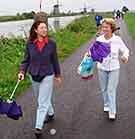Good Walking Techniques...

...are the difference between a good and a poor walking result. Good walking techniques keep you coming back because you feel great when you walk
The four elements of good walking technique include:
1. Proper Posture
How you hold your body directly affects affects how comfortably
and easily you walk. You breathe easier and avoid back pain.
- Stand up straight.
- Think and be tall. Don't arch your back.
- Leaning forward or back puts extra strain on your back muscles. Try not to do it.
- Look straight ahead. Pick a spot to look at about 20 feet or more in front of you.
- Keep you chin parallel to the ground to reduce strain on your neck and back.
- Shrug once. Then let your shoulders fall slightly to the back and relax.
- Suck in your stomach. More!
- Tuck in your butt and rotate your hips forward slightly. This keeps you from arching your back.
2. Arm Motion
...lends power to your walking, helps balance your leg motion and results in 5-10% more calories burned while you're walking.
- Bend your elbow 90 degrees.
- Keep your hands loose and your fingers naturally curled and relaxed. Don't clench your fists. Clenching raise your blood pressure. .
- Swing your arms fairly straight to the front and back as you walk. Don't let your hands cross the center point of your body
- Keep your elbows close to your body - don't go 'chicken wing'.
- On the forward motion, keep your hand lower than your breastbone. High arm motions doesn't help propel you.
- If the arm motion
tires you at first, just do do it for 5-10 minutes at a time, then
let your arms rest. Work up to doing it for your whole walk.
3. Taking A Step
We know you know how to take a step but just to be sure...

- Strike the ground first with your heel.
- Roll through the step from heel to toe.
- Push off with your toes.
- Bring back foot forward, strike ground with heel and repeat.
Shoe sole flexibility is important for comfortable walking. If your feet are slapping down rather than rolling through the step, your shoe soles are too stiff. You can read more about how to choose your Best Walking Shoes on this page.
4. Walking Stride
- Take frequent, smaller steps. Your stride should be longer behind than out in front of your body.
- Don't extend your stride to increase speed (over-striding). This is inefficient and potentially harmful.
- Your back leg 'push' drives your forward. You get that power from your back leg as you push off the toe. This is the key to powerful and efficient walking. Your forward leg has no pushing power.
- Fast walkers train themselves to increase the number of steps per minute they take and make full use of the back stride.
Let's Walk!
This is all pretty basic stuff. Thanks for sticking with it though. There is actually a lot more to this walking than you might think. Check out Walking Tips for a few more ideas if you like too.
Now go practice what you've learned here.
Top of Walking Techniques
Return to Fitness Walking Programs
To Stretching Exercises
Share this page with your friends by clicking our "LIKE" button below. Thanks for sharing!
|
Start your program NOW!
Check This Out!
Another Rewarding Way
To Spend Your Time
Between Walks!

Stay Informed!
Subscribe To Our FREE Newsletter Today!






New! Comments
Have your say about what you've just read! Leave us your comment in the box below.